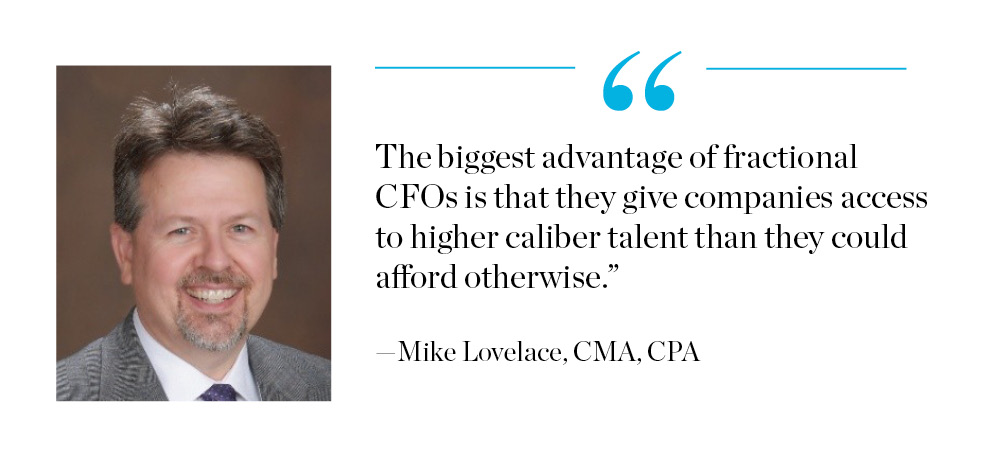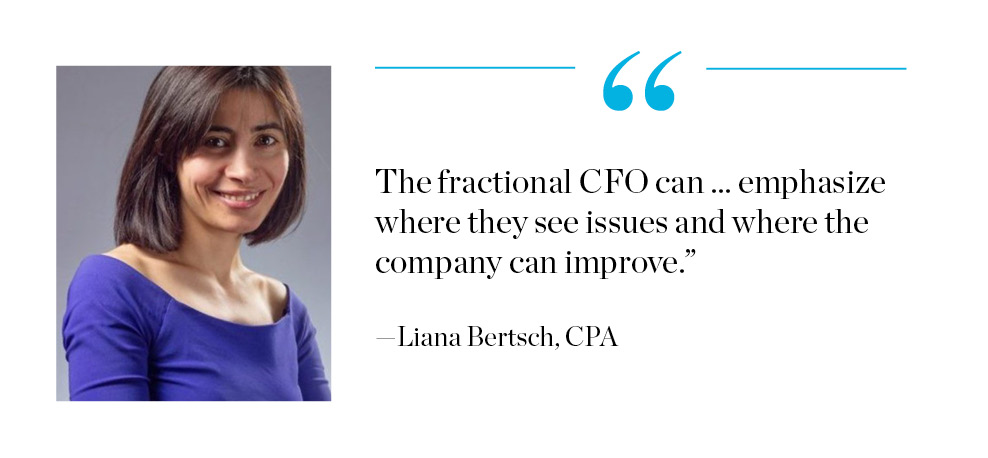The gig economy revolution, once defined by rideshare apps and conventional freelance roles, is climbing the organizational ladder. Businesses of all sizes are increasingly turning to fractional leaders to guide them through transformations and transitions—and that extends to finance leadership roles such as CFOs and controllers.
A 2024 global survey by Business Talent Group found a 23% annual increase in the need for experienced interim leaders, with Fortune 100 companies seeing a 117% increase in the use of C-suite interim leaders since 2022. In the finance world, requests for interim CFOs rose 46% from 2023 to 2024.
Fractional finance leaders work on a part-time or temporary basis, bringing high-level expertise and strategic know-how without the cost of a full-time position. Fractional hires can also bring valuable external perspectives to help reveal issues and opportunities that internal staff might overlook.
“Fractional leadership is not about outsourcing. It’s about helping management drive certain things—and helping them make better decisions,” said Ollie Wood, founder of Foundational, a fractional leadership services firm in Singapore.
Whether companies are looking to fill short-term financial leadership gaps or leverage external experience to accelerate growth and spur agility, they can turn to fractional CFOs and controllers to help transform the finance function.
How can organizations reap the maximum benefits from fractional financial leadership? Three experienced fractional CFOs explain what steps companies can take to build a fractional leadership blueprint.
What Can Fractional Leaders Do for Your Business?
For most organizations, the primary advantage of hiring a fractional financial leader comes down to the bottom line. With the median annual salary for U.S.-based CFOs at nearly $450,000, organizations might find themselves priced out of hiring a full-time CFO.
“The biggest advantage of fractional CFOs is that they give companies access to higher caliber talent than they could afford otherwise,” said Mike Lovelace, CMA, CPA, a fractional CFO and advisory practice leader at MGR Accounting Recruiters in San Antonio, Texas. He likens hiring a fractional CFO to renting a sports car for a special occasion, when you normally drive a minivan—it’s an opportunity to level up without breaking the bank.
Fractional leaders help bridge an organization’s day-to-day financial operations of an organization and its long-term strategic development. Management accountants or analysts might be able to handle the former, but they can’t necessarily take the next step to identify and solve larger problems.
“A lot of companies will just hire an accountant or a controller who has a general understanding of how to do bookkeeping but doesn’t know the higher level—where you can streamline, where you have miscommunications between the departments, what things are working and what’s not,” said Liana Bertsch, CPA, fractional CFO at the CFO Centre USA.
“The fractional CFO can not only provide more accurate financials, but can also emphasize where they see issues and where the company can improve.”
And because fractional leaders typically have worked for a range of companies, they can draw on each experience to provide new perspectives and approaches when companies hire them.
“I’ve worked in all kinds of industries, organization sizes, cultural environments, and corporate cultures,” said Lovelace. “Compare that to somebody an organization could afford to buy and put on staff full-time who just hasn’t seen as much. A company may just accept that, ‘Yeah, it takes a long time for us to collect money from customers,’ or ‘All of our vendors are terrible.’ Someone coming in fresh with an enormous amount of experience can say, ‘I've seen elsewhere that it doesn’t have to be like this.’”
Honesty is another powerful tool that fractional leaders can bring to the table, according to Bertsch. Because they’re not as emotionally involved in the company as full-time employees might be—particularly owners and founders—fractional leaders might feel more empowered to share feedback and insights that shake up the norm.
“Owners who are also involved with the companies, usually with small companies, are very emotionally attached to the company, so a lot of the time they don’t see the big picture,” Bertsch said. “That’s the advantage of having someone who is more objective with no emotional attachment. It’s not their baby. They’re just going to give you all the information.”
Finding the Right Fractional Fit
Companies that hire a fractional leader must do so with eyes wide open. Even the most skilled financial leader won’t be able to grow a business on a barren landscape. In order for the fractional leadership dynamic to succeed, the organization must understand why the fractional leader is being brought in—then cultivate an environment for that person to succeed.
Turning to a fractional leader for the financial function can help companies avoid common hiring mistakes that are the result of poor decision making, said Wood. Those mistakes include:
- Hiring a full-time CFO too quickly without taking fit into account.
- Relying on an accountant or controller to handle additional responsibilities that actually require a more forward-thinking accounting and finance professional.
- Waiting too long to hire a full-time CFO—and suffering from poor financial management in the meantime.
In all three situations, fractional leaders can demonstrate and deliver immediate value, earning early buy-in from the organization and freeing management up to focus on other parts of the company, Wood said. Realizing these benefits can also give a company more time to determine when and how it might hire a full-time financial leader in the future.
“It gets rid of a lot of the headaches and the worries companies have. You genuinely see the relief,” Wood said. “It’s often just a massive weight off their mind, and that allows them to focus on all the other parts of the business.”
Although Wood works mostly with start-ups, he said more mature organizations can also benefit from fractional leadership. For example, a large organization strong in internal finance might bring in fractional talent to help with mergers and acquisitions. In that case, the fractional leader could even work alongside a full-time CFO or VP of finance. Fractional CFOs can also fill a gap for organizations looking to phase out their current CFO. Having the fractional leader in place can give the company more time to rethink its financial leadership needs and find its next full-time CFO.
Easing the Fractional Transition
Regardless of why fractional leaders are hired, organizations can maximize the benefits of these fractional relationships by easing the transition as much as possible. Transparency is key, particularly early on when the new leader is just learning where things stand.
For instance, Bertsch encourages her clients to provide access to all the company’s financial information right away, rather than have the organization try to limit costs by attempting to self-diagnose its issues. She even structures her fees to incentivize organizations to share as much information as possible when she starts.
“I structure a fixed fee on the implementation phase so they’re not hiding things,” Bertsch said. “I say, ‘Just throw all the information at me, and I’ll filter what’s the noise and what’s important.’ And then we can have the conversation based on that.”
Things can get sticky when the fractional leader is being brought in to clean up a mess made by other financial leaders—especially if any of those employees are still with the company. Wood said his fractional CFOs will often start with minimal engagement as a way to ease into the role and client relationship. For instance, the fractional leader might identify a specific project to focus on for the first few months.
“That allows us to come in, see the lay of the land, and then, if there needs to be a transition, not only does senior management have a bit more trust in the fractional leader, but you also have a lot more information on how to make that transition of phasing someone out less awkward,” said Wood.
Don’t Force Fractional
Companies that assess their fractional leadership needs and develop a strong transition plan can help fractional hires deliver actual benefits. But sometimes fractional CFOs and other stop-gap finance leaders simply aren’t a good fit.
Problems can vary—and both sides can be to blame. Misunderstandings can arise about responsibilities and unrealistic expectations. Disputes over fees can happen if contracts are not buttoned up from the start. Or change-resistant organizations can show reluctance to embrace fresh ideas from fractional leaders.
Having a new fractional CFO focus on a specific project or problem is one way to evaluate the fit, Wood said. By starting small, both sides can monitor the fractional relationship—and, if it’s not a good fit, choose a different direction with minimal disruption to the larger financial function.
The best solution, regardless of the cause, is to address the problem as soon as possible, rather than continue to force the issue, even if that means an earlier than anticipated exit for the fractional CFO.
“It’s important to head it off before it reaches the point where it gets contentious,” said Lovelace. “If I’m preaching and you’re not listening, you change the preacher—you don’t change the congregation. It’s easier to say, ‘I don’t think this is giving you the results you want. Let’s not try to push this rock up the hill.’”
So You Want to be a Fractional Leader?Transitioning to fractional leadership is a potentially attractive career option for accounting and finance professionals. Is it the right path for you? Here are some things to consider before taking the part-time plunge: Learn which lanes suit you best.Fractional hires get to choose their clients. On the flip side, they need to live with those choices. The lesson? Choose wisely—and learn from each experience. Liana Bertsch, CPA, said past fractional roles have led her to rule out certain industries, such as music and restaurants. She prefers software as a service, professional services, and e-commerce. “I feel at the end of day it’s always more about people,” she said. “If I don’t feel it’s a good fit, I don’t even take the client.” Get comfortable with radical candor.For Mike Lovelace, CMA, CPA, the best part about being a fractional hire is not having to play the political games that come with being a full-time, in-house CFO. “There’s a difference between building consensus and building alliances,” he said. “I see consensus being about working toward the same goal. I see alliances as potentially having to navigate a backstabbing environment.” Lovelace believes he’s able to be more transparent—and, by extension, effective—knowing his gig is temporary. “I’m not trying to stay there forever. I’m not trying to retire there as my full-time meal ticket. I can tell somebody that their baby’s ugly.” Grow from unique experiences—and apply them along the way.Bertsch has worked as an in-house CFO and as a consultant but she found her comfort zone as a fractional finance leader because of the variety of experiences—all of which help her adapt to new roles and be more effective at each fractional job. “I’ve had clients in so many different industries, and they all think very differently and they all tell you something different, not just from a finance perspective but overall about growing and managing a company,” Bertsch said. “Being in those management meetings, I learned quite a lot, and there’s nothing that stops you from using those same concepts across industries and clients.” |





